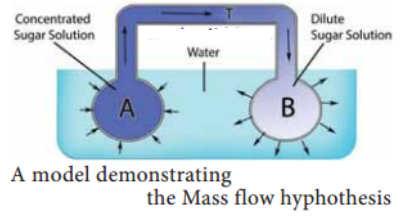Mass flow theory was first proposed by Munch (1930) and elaborated by Crafts (1938). According to this hypothesis, organic substances or solutes move from the region of high osmotic pressure (from mesophyll) to the region of low osmotic pressure along the turgor pressure gradient. The principle involved in this hypothesis can be explained by a simple physical system as shown in figure.
Two chambers “A” and “B” made up of semipermeable membranes are connected by tube “T” immersed in a reservoir of water. Chamber “A” contains highly concentrated sugar solution while chamber “B” contains dilute sugar solution.
The following changes were observed in the system.
. The high concentration sugar solution of chamber “A” is in a hypertonic state which draws water from the reservoir by endosmosis.
2. Due to the continuous entry of water into chamber “A” , turgor pressure is increased.
3. Increase in turgor pressure in chamber “A” force, the mass flow of sugar solution to chamber “B” through the tube “T” along turgor pressure gradient.
4. The movement of solute will continue till the solution in both the chambers attains the state of isotonic condition and the system becomes inactive.
5. However, if new sugar solution is added in chamber “A” , the system will start to run again.
A similar analogous system as given in the experiment exists in plants: Chamber “A” is analogous to mesophyll cells of the leaves which contain a higher concentration of food material in soluble form. In short “A” is the production point called “source”. Chamber “B” is analogous to cells of stem and roots where the food material is utilized. In short “B” is consumption end called “sink”. Tube “T” is analogous to the sieve tube of phloem.
Mesophyll cells draw water from the xylem (reservoir of the experiment) of the leaf by endosmosis leading to increase in the turgor pressure of mesophyll cell. The turgor pressure in the cells of stem and the roots are comparatively low and hence, the soluble organic solutes begin to flow en masse from mesophyll through the phloem to the cells of stem and roots along the gradient turgor pressure.
In the cells of stem and roots, the organic solutes are either consumed or converted into insoluble form and the excess water is released into xylem (by turgor pressure gradient) through cambium.

Merits:
1. When a woody or herbaceous plant is girdled, the sap contains high sugar containing exudates from cut end.
2. Positive concentration gradient disappears when plants are defoliated.
Objections:
1. This hypothesis explains the unidirectional movement of solute only. However, bidirectional movement of solute is commonly observed in plants.
2. Osmotic pressure of mesophyll cells and that of root hair do not confirm the requirements.
3. This theory gives passive role to sieve tube and protoplasm, while some workers demonstrated the involvement of ATP.